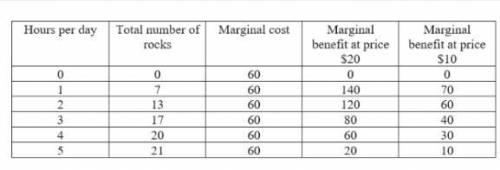
Business, 21.12.2019 05:31 woodfordmaliky
Zoe is trying to decide how to divide her time between her job as a wedding photographer, which pays $40 per hour for as many hours as she chooses to work, and as a rock collector, in which case her pay depends both on the price of the rocks and the number of them she finds. these are special rocks so they have value! earnings aside, zoe is indifferent between the two jobs. the number of rocks she can expect to find depends on the number of hours she searches: hours per day total rocks per day0 01 72 133 174 205 21a. the marginal cost of spending one hour hunting for rocks is equal to $ .b. if the price per rock is $10 then the marginal benefit of spending one hour hunting for rocks is equal to $ .c. if the price per rock is $20, then her best choice is to spend hours hunting for rocks. d. if the price per rock falls to $10 then her best choice is to spend hours hunting for rocks.

Answers: 1


Other questions on the subject: Business

Business, 21.06.2019 22:30, ringo12384
Quantitative problem: you need $20,000 to purchase a used car. your wealthy uncle is willing to lend you the money as an amortized loan. he would like you to make annual payments for 4 years, with the first payment to be made one year from today. he requires a 8% annual return. what will be your annual loan payments? round your answer to the nearest cent. do not round intermediate calculations. $ how much of your first payment will be applied to interest and to principal repayment? round your answer to the nearest cent. do not round intermediate calculations. interest: $ principal repayment
Answers: 1

Business, 22.06.2019 05:50, marjae188jackson
Acompany that makes shopping carts for supermarkets and other stores recently purchased some new equipment that reduces the labor content of the jobs needed to produce the shopping carts. prior to buying the new equipment, the company used 6 workers, who produced an average of 79 carts per hour. workers receive $16 per hour, and machine coast was $49 per hour. with the new equipment, it was possible to transfer one of the workers to another department, and equipment cost increased by $11 per hour while output increased by four carts per hour. a) compute the multifactor productivity (mfp) (labor plus equipment) under the prior to buying the new equipment. the mfp (carts/$) = (round to 4 decimal places). b) compute the productivity changes between the prior to and after buying the new equipment. the productivity growth = % (round to 2 decimal places)
Answers: 3

Business, 22.06.2019 11:40, sriggins1375
Manipulation manufacturing's (amm) standards anticipate that there will be 5 pounds of raw material used for every unit of finished goods produced. amm began the month of maymay with 8,000 pounds of raw material, purchased 25,500 pounds for $ 15,300 and ended the month with 7,400 pounds on hand. the company produced 4,9004,900 units of finished goods. the company estimates standard costs at $ 1.10 per pound. the materials price and efficiency variances for the month of maymay were:
Answers: 1

Business, 22.06.2019 16:20, valdezavery1373
The assumptions of the production order quantity model are met in a situation where annual demand is 3650 units, setup cost is $50, holding cost is $12 per unit per year, the daily demand rate is 10 and the daily production rate is 100. the production order quantity for this problem is approximately:
Answers: 1
You know the right answer?
Zoe is trying to decide how to divide her time between her job as a wedding photographer, which pays...
Questions in other subjects:

Mathematics, 19.09.2020 01:01

History, 19.09.2020 01:01

Mathematics, 19.09.2020 01:01

Mathematics, 19.09.2020 01:01



Social Studies, 19.09.2020 01:01






